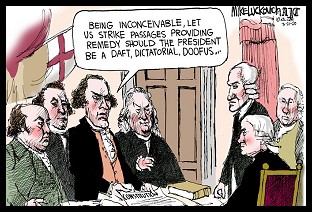Guest Blogged by John Gideon
Election Science Institute (ESI) of San Francisco California was hired to investigate and report on problems with the May primary election in Cuyahoga County, Ohio. The 240-page report was just released this month (August), and some in the elections community have ignored a large majority of the report and zeroed in on a single aspect that supports their thesis that voters don't need any paper, even when voting on a Direct Recording Electronic (DRE) voting machine.
Daniel Tokaji is an Assistant Professor of Law at the Ohio State University’s Moritz College of Law and the Associate Director of Election Law at Moritz. He has testified against a voter verified paper audit trail (VVPAT) to a US House committee and the Election Assistance Commission..
In his paper on the ESI report, Tokaji ignores many significant findings of the report and distorts the overall findings by highlighting only the compromised VVPAT. As pointed out by VotersUnite.Org in their analysis of the ESI report, there was much more substance from ESI than just VVPAT printer problems:
The risk is much higher than the possibility of compromised recounts. The clear and present danger is the thwarting of the public will in the initial, official outcomes of elections entrusted to these machines.
In his 'single-focused' review Tokaji points to another reviewer's report that agrees with his. This second report, which Tokaji says is a "cogent analysis", is from one of electionline.org's reporters, Dan Seligson. Seligson, like Tokaji, ignored everything in the ESI report except the statements about VVPAT problems.
In his report Seligson says:
ESI researchers found that nearly 10 percent of VVPAT ballots sampled were in some way compromised, damaged or otherwise uncountable, an alarmingly high proportion for a state that requires that paper be used as the ballot of record in the event of a recount.
So, Seligson dug 93 pages into a 240-page report to find these failures of the VVPAT and he ignored nearly every other problem ESI found. Why did neither Seligson nor Tokaji report on the Key Finding of the ESI report? Here's what VotersUnite says:
“The machines’ four sources of vote totals – VVPAT individual ballots, VVPAT summary, election archive, and memory cards – did not agree with one another.”
In a correctly functioning system, all vote totals reported by the system will be identical, regardless of the source of the report— that is, regardless of whether those totals are reported on VVPAT summaries, individual VVPAT ballots, or electronically stored data.
However, ESI’s investigation found discrepancies in every pair of vote-data sets they compared. The four types of data used in the comparison were gubernatorial totals reported by:
♦ VVPAT summary data printed when the VVPAT tape is full or at the end of the day
♦ VVPAT ballots individually hand counted
♦ DRE memory card totals, recorded electronically and used to tally the votes
♦ DRE election archive totals, recorded electronically inside the machine
Neither of the two pundits questioned why, in many cases, ESI found that there were more votes registered on VVPAT summaries than were registered electronically. Neither investigated why totals from memory cards did not match the DRE archive totals. Neither realized that these problems could not be printer failures but had to be system failures. Or did they?
VotersUnite correctly reports:
In its summation, VotersUnite states:
Several reviewers of the ESI report have focused almost exclusively on the problems with the VVPAT, to the extent that the titles of their articles suggest the report is only about the VVPAT failures.
We believe these authors are missing the point of the data that surfaced during ESI’s investigation. Certainly, Diebold’s implementation of the VVPAT was deplorable. But worse than that, the investigation discovered that all of the machine vote counts in the May 2006 primary were internally inconsistent and therefore thoroughly unreliable.
Significant discrepancies were found in every comparison of data that should have matched. It is impossible to know the true totals.
The Executive Summary of the ESI threat analysis, could not be more clear:
“Any issue that leads to unreliable consolidation of data is serious because thousands of votes could be lost or shifted by accident in the electronic count.”
In the electronic count!
Instead of acknowledging the certainty that future electronic totals will be so inconsistent from one medium to another that the true totals cannot be determined, Tokaji, Seligson, and [Michael] Alvarez warn of compromised VVPAT ballots, printer failures, and problems with VVPAT technology.
Instead of pointing to the high risk of perverted official results, based on electronic data which has been proven to be unreliable, these three reviewers warn that recounts could be compromised since they must rely on the VVPAT ballots.
Indeed, Dan Tokaji concludes his review with this:
“Unless the mechanical and/or training issues found in the ESI report are resolved, it is quite likely that reliance on the VVPAT in recounts will lead to the wrong result in some future election.”
However, the data presented in the ESI report clearly demonstrate the real threat — not problems caused by adding inferior VVPAT technology to DREs, but the severe internal inconsistencies in the DREs’ electronic vote-total reports. These inconsistencies cast serious doubt on all election outcomes reported by the machines — that is, whichever of the differing reports is deemed official.
The risk is much higher than the possibility of compromised recounts. The clear and present danger is the thwarting of the public will in the initial, official outcomes of elections entrusted to these machines.
We agree with this summation and we wish that supposed intellects and experts like Tokaji and Seligson would report all of the facts and not just those that they can spin into an argument for their point of view. The data reviewed by ESI's team shows huge problems with the Diebold voting machine hardware and software used by the county. That's where the problem was in May. That's what ESI reported. That's what some pundits have ignored.
NOTE: Look For More Breaking News From Cuyahoga County Later Today. ESI, the County Board of Elections and Diebold Are All In A Meeting As I Write This.


 Judge Dismisses Long-Running Challenge to GA's Unverifiable, Insecure E-Vote System: 'BradCast' 4/1/25
Judge Dismisses Long-Running Challenge to GA's Unverifiable, Insecure E-Vote System: 'BradCast' 4/1/25 'Green News Report' 4/1/25
'Green News Report' 4/1/25
 Bad Court and Election News for Trump is Good News for America: 'BradCast' 3/31/25
Bad Court and Election News for Trump is Good News for America: 'BradCast' 3/31/25 Sunday 'Great Start!' Toons
Sunday 'Great Start!' Toons Vets Push Back at Trump, Musk Plan to Slash Health Care, 80K V.A. Jobs: 'BradCast' 3/27/25
Vets Push Back at Trump, Musk Plan to Slash Health Care, 80K V.A. Jobs: 'BradCast' 3/27/25 'Green News Report' 3/27/25
'Green News Report' 3/27/25 Signal Scandal Worsens for Trump, GOP; Big Dem Election Wins in PA: 'BradCast' 3/26
Signal Scandal Worsens for Trump, GOP; Big Dem Election Wins in PA: 'BradCast' 3/26 'Emptywheel' on Why Trump NatSec Team Should 'Resign in Disgrace' After Signal Chat Debacle: 'BradCast' 3/25/25
'Emptywheel' on Why Trump NatSec Team Should 'Resign in Disgrace' After Signal Chat Debacle: 'BradCast' 3/25/25 'Green News Report' 3/25/25
'Green News Report' 3/25/25 USPS 'Belongs to the People, Not the Billionaires': 'BradCast' 3/24/25
USPS 'Belongs to the People, Not the Billionaires': 'BradCast' 3/24/25 Sunday 'Suddenly Conceivable' Toons
Sunday 'Suddenly Conceivable' Toons 'Green News Report' 3/20/25
'Green News Report' 3/20/25 We're ALL Voice of America Now: 'BradCast' 3/20/25
We're ALL Voice of America Now: 'BradCast' 3/20/25 What Trump's 'Timber Production Expansion' Means (and Costs): 'BradCast' 3/19/25
What Trump's 'Timber Production Expansion' Means (and Costs): 'BradCast' 3/19/25 Courts Largely Holding Against Trump, Musk Lawlessness: 'BradCast' 3/18/25
Courts Largely Holding Against Trump, Musk Lawlessness: 'BradCast' 3/18/25 Chief VOA Reporter on Outlet Falling Silent First Time Since 1942: 'BradCast' 3/17/25
Chief VOA Reporter on Outlet Falling Silent First Time Since 1942: 'BradCast' 3/17/25 Trump EPA Unveils Plans to Endanger, Sicken Americans: 'BradCast' 3/13/25
Trump EPA Unveils Plans to Endanger, Sicken Americans: 'BradCast' 3/13/25 Trump Nixed Enforce-ment Against 100 Corp. Lawbreakers: 'BradCast' 3/12/25
Trump Nixed Enforce-ment Against 100 Corp. Lawbreakers: 'BradCast' 3/12/25 Bad Day for 'Strongmen': 'BradCast' 3/11
Bad Day for 'Strongmen': 'BradCast' 3/11 WI Election Could Flip Supreme Court Control, Musk Jumps In: 'BradCast' 3/10
WI Election Could Flip Supreme Court Control, Musk Jumps In: 'BradCast' 3/10
 VA GOP VOTER REG FRAUDSTER OFF HOOK
VA GOP VOTER REG FRAUDSTER OFF HOOK Criminal GOP Voter Registration Fraud Probe Expanding in VA
Criminal GOP Voter Registration Fraud Probe Expanding in VA DOJ PROBE SOUGHT AFTER VA ARREST
DOJ PROBE SOUGHT AFTER VA ARREST Arrest in VA: GOP Voter Reg Scandal Widens
Arrest in VA: GOP Voter Reg Scandal Widens ALL TOGETHER: ROVE, SPROUL, KOCHS, RNC
ALL TOGETHER: ROVE, SPROUL, KOCHS, RNC LATimes: RNC's 'Fired' Sproul Working for Repubs in 'as Many as 30 States'
LATimes: RNC's 'Fired' Sproul Working for Repubs in 'as Many as 30 States' 'Fired' Sproul Group 'Cloned', Still Working for Republicans in At Least 10 States
'Fired' Sproul Group 'Cloned', Still Working for Republicans in At Least 10 States FINALLY: FOX ON GOP REG FRAUD SCANDAL
FINALLY: FOX ON GOP REG FRAUD SCANDAL COLORADO FOLLOWS FLORIDA WITH GOP CRIMINAL INVESTIGATION
COLORADO FOLLOWS FLORIDA WITH GOP CRIMINAL INVESTIGATION CRIMINAL PROBE LAUNCHED INTO GOP VOTER REGISTRATION FRAUD SCANDAL IN FL
CRIMINAL PROBE LAUNCHED INTO GOP VOTER REGISTRATION FRAUD SCANDAL IN FL Brad Breaks PA Photo ID & GOP Registration Fraud Scandal News on Hartmann TV
Brad Breaks PA Photo ID & GOP Registration Fraud Scandal News on Hartmann TV  CAUGHT ON TAPE: COORDINATED NATIONWIDE GOP VOTER REG SCAM
CAUGHT ON TAPE: COORDINATED NATIONWIDE GOP VOTER REG SCAM CRIMINAL ELECTION FRAUD COMPLAINT FILED AGAINST GOP 'FRAUD' FIRM
CRIMINAL ELECTION FRAUD COMPLAINT FILED AGAINST GOP 'FRAUD' FIRM RICK SCOTT GETS ROLLED IN GOP REGISTRATION FRAUD SCANDAL
RICK SCOTT GETS ROLLED IN GOP REGISTRATION FRAUD SCANDAL VIDEO: Brad Breaks GOP Reg Fraud Scandal on Hartmann TV
VIDEO: Brad Breaks GOP Reg Fraud Scandal on Hartmann TV RNC FIRES NATIONAL VOTER REGISTRATION FIRM FOR FRAUD
RNC FIRES NATIONAL VOTER REGISTRATION FIRM FOR FRAUD EXCLUSIVE: Intvw w/ FL Official Who First Discovered GOP Reg Fraud
EXCLUSIVE: Intvw w/ FL Official Who First Discovered GOP Reg Fraud GOP REGISTRATION FRAUD FOUND IN FL
GOP REGISTRATION FRAUD FOUND IN FL


































